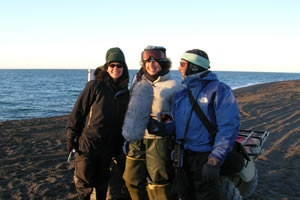
 |
Arctic lake 'boils' with methaneSeptember 26, 2007Courtesy of Far North Science University of Alaska Fairbanks scientist Katey Walter just wanted to show a National Public Radio news crew a smidgin of methane seeping from a lake on Alaska's North Slope near Barrow. It's all part of her investigations into the supergreenhouse gas, and how it oozes into the atmosphere all over the Far North. 
Methane seekers: Radio reporter Melissa Block, UAF scientist Katey Walter, and NPR producer Art Silverman Bacteria that digest dead vegetation and other edible gunk on the lake bottom produce methane that gets trapped in the muck, sometimes for eons. When lake-bottom permafrost melts in late summer, this flammable gas bubbles up into the air. A potentially huge problem in the event of widespread meltdown of the Far North's "permanently frozen" earth, this methane venting occurs on a small scale wherever vegetation rots. But Walter and the journalists came upon a churning, bubbling spot in the middle of the lake located on the vast brown tundra near Barrow. "When they reached their destination," wrote UAF writer Sandra Boatwright in an online story, "Walter and the crew found even more than they bargained for - A lake violently boiling with escaping methane."
Katey Walter "It was cold, wet and windy. We were dropped off in the middle of nowhere by a helicopter and paddled out to a huge methane plume in the middle of the lake with no idea what to expect, how strong the bubbling plume would be, whether or not our raft would stay afloat, how dangerous it would be to breathe the gas," said Walter, an assistant professor in UAF's Institute of Northern Engineering and International Arctic Research Center. "The violent streams of bubbles made the lake appear as if it were boiling, but the water was pretty cold." Walter studies methane emissions from arctic lakes, especially the connection between thawing permafrost and climate change. As permafrost around a lake's edges thaws, the organic material in it - dead plants and animals - can enter the lake bottom, where bacteria convert it to methane, which bubbles into the atmosphere, sometimes in a spectacular fashion. Walter said this summer's fieldwork indicates that methane hotspots, such as the one she and the crew experienced, can come from various sources, not just thawing permafrost. Her next goal is to identify and quantify the sources of the methane hotspots around Alaska. "It is unlikely that this methane plume was related to permafrost thaw," said Walter, adding that the methane boiling out of the lake was more likely related to natural gas seepage. "Should large quantities of methane be released from methane hydrates, for instance, in association with permafrost thaw, then we could have large sudden increases in atmospheric methane with potentially large affects on global temperatures." A radio story by Melissa Block - with text, links and a 15-image slide show posted on-line - was aired on NPR's All Things Considered earlier in the week.
Source: UAF NPR also posted Walter's recollections of doing such adventure science in a Siberian lake. Ever light a batch of wild methane? Walter calls it thrilling. "You can have fireballs that shoot into the air as tall as spruce trees," she told Block.Walter was part of a team that studied methane releases in Siberian lakes, and published results in the journal Nature in the fall of 2006. Frozen bubbles in Siberian lakes are releasing methane, a greenhouse gas, at rates that appear to be "five times higher than previously estimated" and acting as a positive feedback to climate warming, Walter said in an Institute of Arctic Biology story posted last year. "We realized that our previous estimates were missing a very large and important component of lake emissions - in these bubbles were the dominant source of methane from lakes." |
|